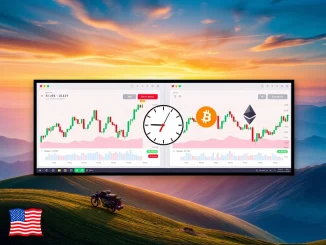
The world of cryptocurrency trading can be incredibly fast-paced and volatile. Recently, market participants witnessed a stark reminder of this reality as significant crypto futures liquidation events swept across major exchanges.
Imagine this: in the span of just 60 minutes, traders saw positions valued at a staggering $334 million wiped out. Expanding the view to the past 24 hours reveals an even larger scale of impact, with nearly a billion dollars — specifically $976 million worth of futures — liquidated. These aren’t just numbers; they represent closed positions, margin calls, and significant losses for many navigating the futures market.
What Exactly is Crypto Futures Liquidation?
For those new to this space, understanding liquidation is crucial. In cryptocurrency trading, especially in the futures market, traders often use leverage. This means they borrow funds to open positions larger than their initial capital (margin).
Liquidation occurs when a trader’s leveraged position falls below a certain margin requirement set by the exchange. If the market moves against their position, and they don’t add more funds (margin), the exchange automatically closes the position to prevent further losses, often resulting in the loss of the trader’s initial margin.
Why Did We See Such Large Liquidations?
Large liquidation events like the one reported — involving large liquidations totaling hundreds of millions — typically happen during periods of significant price swings or heightened market volatility. When prices move sharply and quickly, especially after a period of consolidation or relatively stable prices, many leveraged positions can be pushed past their liquidation thresholds simultaneously.
- Sudden Price Movements: A rapid upward or downward price swing is the primary trigger.
- High Leverage: Traders using high leverage ratios are more susceptible to liquidation from even small price changes.
- Cascading Effects: As positions are liquidated, the forced selling (or buying) can further exacerbate the price move, triggering more liquidations in a domino effect.
Impact on the Cryptocurrency Trading Landscape
Events like these highlight the inherent risks in cryptocurrency trading, particularly with leveraged products. While leverage can amplify gains, it equally amplifies losses, leading to swift liquidations during volatile periods.
The $334 million liquidation in one hour is particularly striking, indicating an extremely rapid and intense price movement within that short timeframe. The nearly $1 billion over 24 hours shows sustained pressure or multiple volatile episodes.
What Can Traders Learn from These Large Liquidations?
These large liquidations offer valuable lessons for anyone involved in cryptocurrency trading:
- Understand Leverage: Be fully aware of how leverage works and the risks involved. Higher leverage increases liquidation risk significantly.
- Risk Management is Key: Never trade with funds you cannot afford to lose. Use risk management tools like stop-loss orders to automatically close positions before liquidation occurs.
- Monitor Market Volatility: Stay informed about market conditions and potential catalysts for price swings.
- Start Small: If you’re new to futures or leverage, start with small position sizes and low leverage to understand the mechanics and risks.
The market volatility that causes crypto futures liquidation is a constant factor in the crypto space. While potentially profitable, the futures market demands respect for risk.
Conclusion: Navigating Volatility and Risk
The recent figures — $334 million liquidated in one hour and $976 million in 24 hours — serve as a powerful reminder of the unpredictable nature of the futures market and the potential for rapid, significant large liquidations during periods of heightened market volatility. Successful cryptocurrency trading, especially with leverage, isn’t just about predicting price movements; it’s fundamentally about managing risk effectively to survive the inevitable volatile swings and avoid becoming another statistic in the next crypto futures liquidation event.



